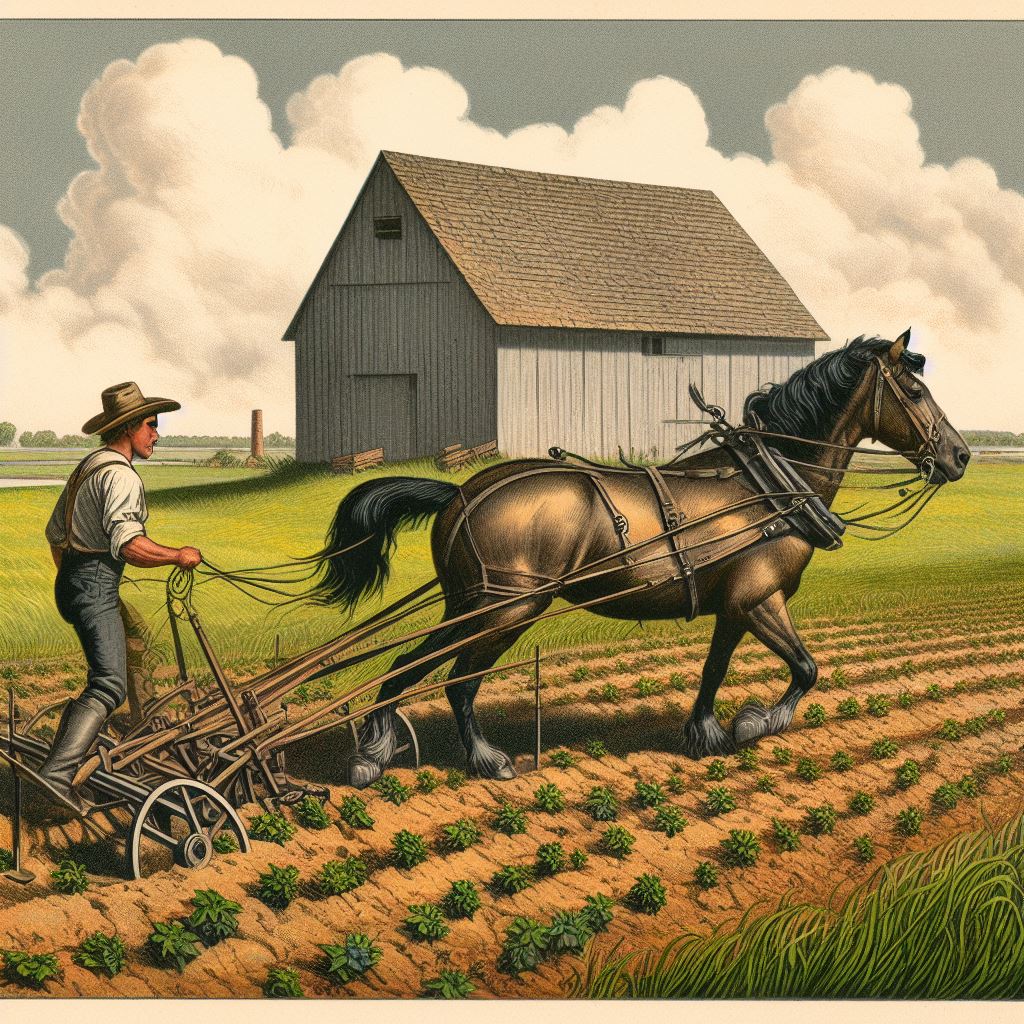Evolution of Farming in the USA: A Historical Overview
Last Updated on November 9, 2023
Introduction
Farming plays a crucial role in the development and prosperity of the United States. The agricultural industry not only provides essential food and resources but also contributes significantly to the nation’s economy.
This blog post presents a historical overview of the evolution of farming in the USA, highlighting its transformative journey.
From Subsistence to Commercial Farming
Farming in the USA was primarily subsistence-based, with families cultivating crops and raising livestock to sustain themselves.
As the country grew, agricultural practices shifted towards commercialization, focusing on the large-scale production of crops for profit.
The Impact of Technological Advancements
The 19th century witnessed remarkable developments in farm technology.
The introduction of machinery such as the steel plow, mechanical reaper, and steam-powered tractors revolutionized farming practices, significantly increasing efficiency and productivity.
These advancements paved the way for massive agricultural expansion.
Agricultural Expansion and Land Distribution
The Homestead Act of 1862 played a vital role in the expansion of farming in the USA. By granting settlers ownership of 160 acres of land, it encouraged migration to the western territories.
The acquisition of new farmland propelled the nation’s agricultural growth.
The Rise of Industrial Agriculture
The late 19th and early 20th centuries brought further advancements and changes to farming. Industrial agriculture emerged, driven by mechanization, synthetic fertilizers, and pesticides.
This new model of farming aimed at maximizing yield and profit, transforming the landscape of American agriculture.
Agricultural Challenges and Modern Innovations
The 20th century presented various challenges to American farmers, including the Dust Bowl and the Great Depression.
However, innovative practices such as crop rotation, irrigation systems, and genetically modified organisms (GMOs) revolutionized farming, adapting to the changing needs of the population.
The evolution of farming in the USA showcases a remarkable journey.
From subsistence farming to commercialization, and from technological advancements to industrial agriculture
The American agricultural industry has constantly adapted to meet the demands of a growing nation.
Understanding this historical overview is vital to appreciate the current state and future prospects of farming in the USA.
Pre-colonial Era
Native American farming practices
- The Native Americans had sophisticated farming techniques.
- They practiced sustainable agriculture, including crop rotation and companion planting.
- They utilized natural resources and had a deep understanding of the land they farmed.
Crops cultivated during this time
- The Native Americans cultivated a wide variety of crops.
- Main crops included maize, beans, squash, sunflowers, and tobacco.
- These crops were essential for their survival and served as staple food sources.
Importance of agricultural techniques
- The Native Americans’ farming techniques played a vital role in their society.
- Farming ensured a reliable food supply for their communities.
- They also traded agricultural products, strengthening cultural exchanges between tribes.
Impact of European colonization on farming practices
- The arrival of Europeans brought significant changes to Native American farming practices.
- The introduction of European crops, such as wheat and barley, influenced their agricultural landscape.
- Euro-American settlers implemented their farming methods, disrupting traditional Native American practices.
In general, the pre-colonial era in the United States was marked by the advanced farming practices of Native American tribes.
Their sustainable agricultural techniques supported their communities and formed the foundation of Native American society.
The cultivation of crops like maize, beans, and squash provided essential sustenance while fostering cultural exchange through trade.
However, with the arrival of European settlers, the introduction of new crops and farming methods drastically changed the agricultural landscape.
These changes disrupted traditional Native American practices and foreshadowed a significant shift in farming practices throughout American history.
Early Agricultural Practices
Traditional Farming Methods in the 17th and 18th Centuries
- Small-scale farming characterized the agricultural practices of the early colonial period.
- Colonists relied on simple hand tools such as hoes and shovels for cultivation.
- Crops like corn, beans, and squash were grown using Native American farming techniques.
- Individual families or small communities owned and managed their own farms.
Subsistence Farming and its Challenges
- Subsistence farming was the dominant agricultural system in the colonies during this era.
- Farmers primarily grew crops to sustain their own families rather than for commercial purposes.
- Challenges like unpredictable weather, limited access to resources, and pests threatened crop yields.
- Self-sufficiency was vital, and any surplus produce was often traded locally for necessities.
Introduction of New Crops and Farming Tools
- The introduction of new crops and farming tools revolutionized American agriculture in the 18th century.
- European settlers introduced wheat, barley, and oats, diversifying the range of crops grown.
- The use of iron plows and seed drills improved efficiency and productivity on farms.
- These technological advancements paved the way for larger-scale agricultural production.
Development of Plantations
- The development of plantations significantly impacted the agricultural landscape in the Southern colonies.
- Planters focused on cash crops like tobacco, rice, and indigo, cultivating vast areas of land.
- Large numbers of enslaved Africans were brought in to work on these plantations.
- The plantation system became a dominant force in American agriculture and economy.
Generally, the early agricultural practices in the USA were diverse and shaped by various factors such as the availability of resources, cultural influences, and technological advancements.
Traditional small-scale farming methods prevailed in the colonial period, primarily driven by subsistence needs.
The introduction of new crops and farming tools brought about significant changes, encouraging larger-scale production.
Meanwhile, the development of plantations, especially in the Southern colonies, had a profound impact on American agriculture and played a significant role in the nation’s history.
Understanding the evolution of farming practices provides valuable insights into the foundation of the agricultural industry we know today.
Read: Migration and its Impact on US Farm Labor Forces
Agricultural Revolution
Technological advancements in the 19th century
During the 19th century, farming in the USA underwent a significant transformation due to technological advancements.
These advancements included the introduction of mechanized equipment such as the steel plow and the reaper.
These technologies improved efficiency and productivity, making it possible to cultivate larger areas of land.
The impact of the Industrial Revolution on farming
The Industrial Revolution brought about sweeping changes in various industries, including agriculture.
It led to the development of new farming techniques and increased production capabilities.
The use of steam-powered machinery revolutionized farming practices and made it easier to work on large farms.
This led to increased yields and the ability to produce surplus crops for trade.
Shift from subsistence farming to commercial agriculture
As technological advancements and industrialization took hold, farming shifted from subsistence to commercial agriculture.
Farmers began producing crops not only for their own consumption but also for sale in the market.
This change allowed farmers to specialize in specific crops and increase their profits.
Rise of agricultural colleges and education
To support the growing agricultural industry, agricultural colleges and educational programs emerged.
These institutions provided training and education to farmers, promoting scientific farming practices.
Agricultural research also expanded, leading to innovations in crop selection, pest control, and soil management.
The knowledge gained from these institutions further drove the progress in farming techniques and productivity.
Overall, the agricultural revolution in the USA during the 19th century was characterized by technological advancements.
The impact of the Industrial Revolution, a shift from subsistence farming to commercial agriculture, and the rise of agricultural colleges and education.
These developments laid the foundation
for the modern farming practices and prosperity in the agricultural sector that we see today.
Read: Exploring the Diverse Crops of American Farmlands
Expansion and Westward Movement
Homesteading and its impact on farming
- Huge tracts of land were given to settlers in the west under the Homestead Act of 1862.
- This resulted in a rapid increase in farming activities and migration to the western territories.
- Homesteading allowed individuals to acquire 160 acres of land for a small fee.
- Many families left the east to start a new life as farmers on the vast western lands.
- Homesteaders faced challenges such as harsh weather conditions, isolation, and limited resources.
- Despite these challenges, homesteading played a significant role in expanding agriculture in the USA.
- The availability of free land led to the establishment of numerous family farms across the west.
- These farms became the backbone of the American agricultural industry.
- The Homestead Act allowed ordinary citizens to accumulate wealth through land ownership and farming.
The role of railroads in agricultural development
- Railroads played a crucial role in the growth and development of agriculture in the USA.
- They provided farmers with an efficient means to transport their products to distant markets.
- Railroads helped connect remote farming communities with urban centers and coastal areas.
- This facilitated the easy exchange of agricultural goods and increased profits for farmers.
- Access to railroads also allowed farmers to obtain necessary supplies and machinery.
- The expansion of rail networks spur the expansion of agricultural production and distribution.
- Transportation became faster, cheaper, and more reliable, making farming more viable and profitable.
- Railroads also contributed to the growth of towns and cities along their routes.
- They brought prosperity and economic development to rural areas by connecting farmer with larger markets.
Farming in the western territories
- Farming in the western territories presented unique challenges due to the arid and unpredictable climate.
- Water scarcity was a major issue and required innovative irrigation techniques to make farming feasible.
- Territorial governments promoted irrigation projects and provided support to farmers.
- Farmers experimented with dry farming and drought-resistant crops to adapt to the harsh conditions.
- Despite the challenges, farming in the west gradually flourished, contributing to national agricultural growth.
- The cultivation of staple crops such as wheat, corn, and livestock farming expanded in the west.
- Ranches also became prevalent in the vast open spaces, supporting cattle and sheep farming.
- The western territories became an essential component of the USA’s agricultural landscape.
- Today, the western states are major contributors to the country’s agricultural output.
Challenges faced by farmers in the late 19th century
- Farmers in the late 19th century faced numerous challenges that threatened their livelihoods.
- Overproduction resulted in falling crop prices, leading to financial hardships for farmers.
- Farmers were highly dependent on credit, which often resulted in debt and foreclosure.
- The monopolistic practices of railroads and grain elevators exploited farmers by charging high transportation and storage fees.
- Natural disasters such as droughts, floods, and pests also devastated crops and livestock.
- These challenges led to the rise of farmer organizations and political movements seeking agrarian reforms.
- The Populist movement emerged, advocating for policies to alleviate the struggles of farmers.
- The farmers’ plight paved the way for future reforms in agricultural policies and practices.
- Despite the difficulties faced, farmers remained resilient and continued to contribute to the nation’s food supply.
The late 19th century marked a period of significant agricultural and socio-political transformations.
Farmers playing a central role in demanding reforms and shaping the direction of agricultural policy in the United States and other countries.
Read: Farming Education & Training Programs in the USA

Modernization and Mechanization
Invention of new farm machinery
- The development of the reaper in the 1830s revolutionized the harvesting process.
- Cyrus McCormick’s invention increased crop productivity and reduced labor requirements.
- The steam-powered thresher allowed for efficient separation of grains from chaff.
- Other advancements, such as the cotton gin and tractors, greatly improved farming practices.
Chemical fertilizers and pesticides
- With the advent of synthetic fertilizers, crops could be grown more intensively.
- Chemical fertilizers provided essential nutrients to the soil, enhancing crop yields.
- The introduction of pesticides helped control pests and increase crop profitability.
- However, the indiscriminate use of these chemicals raised concerns about environmental impacts.
The rise of agribusiness and large-scale farming operations
- The 20th century witnessed the consolidation of farms into larger, corporate-owned operations.
- Agribusinesses took advantage of mechanized farming techniques to maximize profits.
- These large-scale operations introduced economies of scale and specialized production.
- However, they also led to the decline of small family farms and rural communities.
Changes in farming practices and their effects on the environment
- Modern farming techniques have resulted in significant environmental consequences.
- Intensive use of synthetic fertilizers and pesticides has led to water and air pollution.
- Soil erosion has increased due to the removal of natural vegetation and unsustainable practices.
- The loss of biodiversity and habitat destruction have posed threats to ecological balance.
- Efforts are being made to promote sustainable agriculture and reduce environmental impacts.
Essentially, the modernization and mechanization of farming in the USA have transformed the agricultural landscape.
The invention of new farm machinery, introduction of chemical fertilizers and pesticides.
Rise of agribusinesses, and changes in farming practices have greatly impacted productivity, profitability, and the environment.
While these advancements have increased agricultural efficiency, they have also raised concerns about sustainability and the negative consequences on ecosystems.
Striking a balance between technological progress and environmental stewardship is crucial for the future of American farming.
Read: The Role of Farmers in US Community and Culture
Government Involvement and Agricultural Policies
The establishment of the U.S. Department of Agriculture
- In 1862, President Abraham Lincoln signed the legislation that created the U.S. Department of Agriculture (USDA).
- The USDA was established to provide support and guidance to farmers across the country.
- Its primary goal was to promote agricultural development and ensure the success of farming in the United States.
Farm subsidies and financial assistance programs
- The government introduced farm subsidies and financial assistance programs to support farmers during times of crisis.
- These programs aimed to stabilize the agricultural sector and protect farmers from volatile market conditions.
- Subsidies such as crop insurance and disaster relief programs provided financial security to farmers.
Impact of government regulations on farming
- Government regulations have played a significant role in shaping the farming industry in the United States.
- Environmental regulations have been implemented to protect natural resources and promote sustainable farming practices.
- Food safety standards have been enforced to ensure the quality and safety of agricultural products.
Current agricultural policies and their implications
- Current agricultural policies aim to address various challenges faced by the farming industry.
- Policies focus on promoting innovation, enhancing food security, and supporting rural communities.
- Efforts are being made to promote sustainable farming practices to mitigate the impact of climate change.
- Government initiatives provide financial incentives for farmers to adopt environmentally friendly practices.
In essence, government involvement and agricultural policies have played a crucial role in shaping the evolution of farming in the USA.
The establishment of the USDA provided much-needed support and guidance to farmers. Farm subsidies and financial assistance programs have helped stabilize the agricultural sector.
Government regulations have ensured sustainable farming practices and food safety. Current policies focus on promoting innovation, enhancing food security, and supporting rural communities.
Efforts are being made to address climate change and promote sustainable practices. The government’s active involvement continues to shape the future of farming in the United States.
Sustainability and Organic Farming
In recent years, there has been a significant shift towards sustainable and organic farming practices in the United States.
Hailed as a more environmentally-friendly and socially responsible approach, this movement has gained momentum and is transforming the agricultural landscape.
The rise of sustainable and organic farming practices
Traditional farming methods often focused on maximizing yields and profits, often at the expense of the environment.
However, awareness of the negative consequences of such practices sparked a desire for change.
Sustainable farming emerged as a response to this concern. It aims to minimize the use of synthetic inputs, such as fertilizers and pesticides, and emphasizes the integration of environmental, social, and economic principles.
Organic farming, a subset of sustainable farming, takes a more specific approach.
It strictly prohibits the use of synthetic substances and genetically modified organisms (GMOs), relying on natural methods to maintain soil fertility and control pests.
These alternative practices have gained popularity due to their potential benefits.
By reducing chemical use, sustainable and organic farming helps preserve soil health, protect water quality, and promote biodiversity. It also offers consumers healthier and more nutritious food options.
Reevaluating the environmental impact of agriculture
The shift towards sustainable and organic farming practices has prompted a critical evaluation of the environmental impact of agriculture.
Conventional farming techniques, such as monocropping and heavy chemical use, have been under scrutiny.
Monocropping, the practice of cultivating a single crop over a large area, depletes soil nutrients and increases vulnerability to pests and diseases.
Additionally, synthetic pesticides and fertilizers can contaminate water sources, posing risks to human health and ecosystems.
By contrast, sustainable and organic farming methods aim to mitigate such risks. Crop rotation, cover cropping, and natural pest control are employed to maintain soil fertility and reduce reliance on chemicals.
This approach contributes to the long-term sustainability of agricultural systems.
The future of farming in the USA
The rise of sustainable and organic farming signifies a changing landscape for American agriculture. Increasing consumer demand for organic produce has led to an expansion of organic farming operations.
According to the Organic Trade Association, organic sales in the United States reached $55.1 billion in 2019, a 5% increase from the previous year.
Furthermore, sustainable farming practices are being adopted by mainstream agricultural institutions.
Universities and research organizations are conducting studies to develop and promote sustainable techniques.
This integration of sustainable principles into conventional farming is known as regenerative agriculture.
The future of farming in the USA lies in finding a balance between productivity and environmental stewardship.
While challenges exist, such as the scalability of organic farming and the need for widespread adoption of sustainable practices, the trends are encouraging.
Ultimately, sustainable and organic farming practices offer a path towards a more resilient and eco-friendly agricultural sector.
By supporting these approaches, we not only ensure the long-term viability of our food systems but also contribute to a healthier planet for future generations.
In fact, sustainability and organic farming have gained traction in the United States as people recognize the importance of environmental stewardship and healthier food.
The transition to these practices and the reevaluation of conventional agriculture’s impacts are crucial steps towards a more sustainable future for farming in the USA.
Conclusion
Main points discussed
Throughout history, farming in the USA has undergone significant changes. From the traditional practices of early.
Native American tribes to the mechanization and industrialization of modern agriculture, the evolution of farming has shaped the nation’s economy and way of life.
Importance of understanding the history of farming in the USA
Understanding the history of farming in the USA is crucial for various reasons. Firstly, it provides insights into the challenges and innovations that farmers have faced.
Enabling us to appreciate their resilience and adaptability.
Additionally, it helps us comprehend how agricultural practices have influenced the environment, food systems, and rural communities.
Studying the evolution of farming allows us to learn from the past and make informed decisions about the future of agriculture.
It prompts us to reflect on sustainable and regenerative practices that prioritize conservation of natural resources, biodiversity, and the well-being of farmers and consumers.
Closing thoughts
The history of farming in the USA is not only a tale of agricultural advancements, but it is also a narrative that connects us to our roots and the land we depend on.
By acknowledging the past and learning from it, we can work towards a more resilient and equitable agricultural system.
Only feeds the nation but also preserves the environment for future generations.
As we move forward, it is essential to appreciate the hard work and dedication of farmers who have shaped the landscape of American agriculture.
By supporting local farmers, advocating for sustainable practices, and fostering agricultural education, we can ensure a prosperous and sustainable future for farming in the USA.
Remember, farming is not just a livelihood; it is the backbone of our nation, and understanding its history is the key to shaping a better tomorrow.


